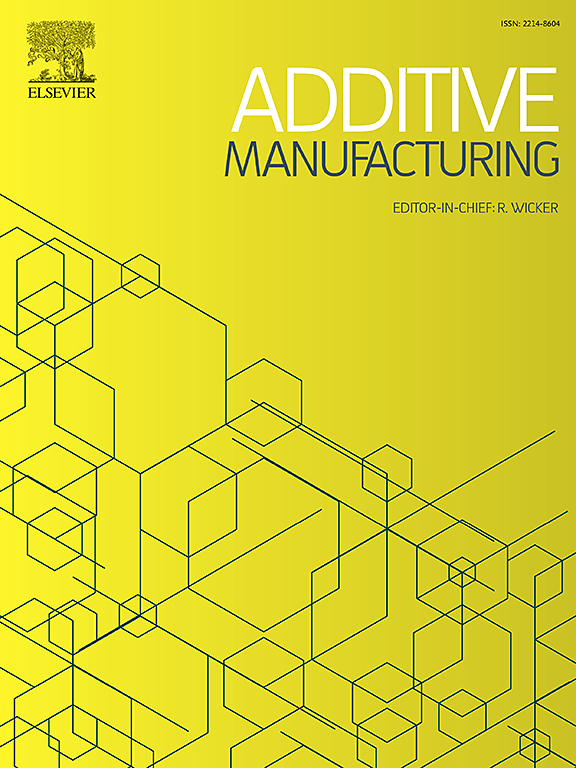用于葡萄糖非酶检测的三维金微柱阵列微结构电极的电流体动力喷射打印
IF 11.1
1区 工程技术
Q1 ENGINEERING, MANUFACTURING
引用次数: 0
摘要
三维(3D)微结构金电极在电化学传感、电催化和储能等方面具有显著的优势。然而,传统的洁净室制造方法,如光刻和气相沉积,依赖于昂贵的设备,并且经常涉及材料浪费。这项工作提出了一种EHD喷射打印工艺,用于使用水性金纳米颗粒墨水制造具有3D金微柱阵列(GMA)的微结构电极。通过COMSOL仿真,提出了单微柱和微柱阵列对静电自聚焦效应的利用和避免,从而获得了GMA的最佳微柱高度和微柱间距。为了解决倾斜和脱离问题,将GMA打印在电化学沉积的金颗粒-枝晶层上,显著增强了微柱与衬底之间的附着力。采用分步烧结工艺制备的三维GMA电极具有良好的结构完整性。随后,将制备的三维GMA电极应用于非酶促电化学葡萄糖检测,结果表明,与平面电极相比,该传感器的混合工作电极的电化学活性表面积增加了534 %,并且获得了6.25 cm2/cm2的高比率。这项工作突出了EHD喷射打印在制造坚固的3D微结构金电极方面的潜力,为生物医学检测和先进医疗技术的应用提供了可靠、经济、有前途的解决方案。本文章由计算机程序翻译,如有差异,请以英文原文为准。
Electrohydrodynamic jet printing of micro-structured electrode featuring 3D gold micropillar array for non-enzymatic detection of glucose
Three-dimensional (3D) micro-structured gold electrodes offer remarkable advantages in electrochemical sensing, electrocatalysis and energy storage. However, conventional cleanroom fabrication methods, such as lithography and vapor deposition, rely on expensive equipment and often involve material waste. This work proposes an EHD jet printing process for fabricating a micro-structured electrode featuring a 3D gold micropillar array (GMA) using water-based gold nanoparticle ink. Through COMSOL simulations, the utilization and avoidance of the electrostatic autofocusing effect is proposed in terms of the single micropillar and micropillar array, thereby obtaining the optimal micropillar height and spacing for the GMA. To address the tilting and detachment issues, the GMA was printed on an electrochemically deposited gold particle-dendrite layer, significantly enhancing the adhesion between the micropillars and substrate. Along with the proposed stepwise sintering process, the fabricated 3D GMA electrode exhibited excellent structural integrity. Subsequently, the fabricated 3D GMA electrode was applied to non-enzymatic electrochemical glucose detection and the results show that, compared to a planar electrode, the hybrid working electrode of the sensor demonstrated a 534 % increase in electrochemical active surface area and a notably high ratio of 6.25 cm2/cm2 was obtained. This work highlights the potential of EHD jet printing for fabricating robust 3D micro-structured gold electrodes, offering a reliable, cost-effective and promising solution for applications in biomedical detection and advanced healthcare technologies.
求助全文
通过发布文献求助,成功后即可免费获取论文全文。
去求助
来源期刊

Additive manufacturing
Materials Science-General Materials Science
CiteScore
19.80
自引率
12.70%
发文量
648
审稿时长
35 days
期刊介绍:
Additive Manufacturing stands as a peer-reviewed journal dedicated to delivering high-quality research papers and reviews in the field of additive manufacturing, serving both academia and industry leaders. The journal's objective is to recognize the innovative essence of additive manufacturing and its diverse applications, providing a comprehensive overview of current developments and future prospects.
The transformative potential of additive manufacturing technologies in product design and manufacturing is poised to disrupt traditional approaches. In response to this paradigm shift, a distinctive and comprehensive publication outlet was essential. Additive Manufacturing fulfills this need, offering a platform for engineers, materials scientists, and practitioners across academia and various industries to document and share innovations in these evolving technologies.
 求助内容:
求助内容: 应助结果提醒方式:
应助结果提醒方式:


